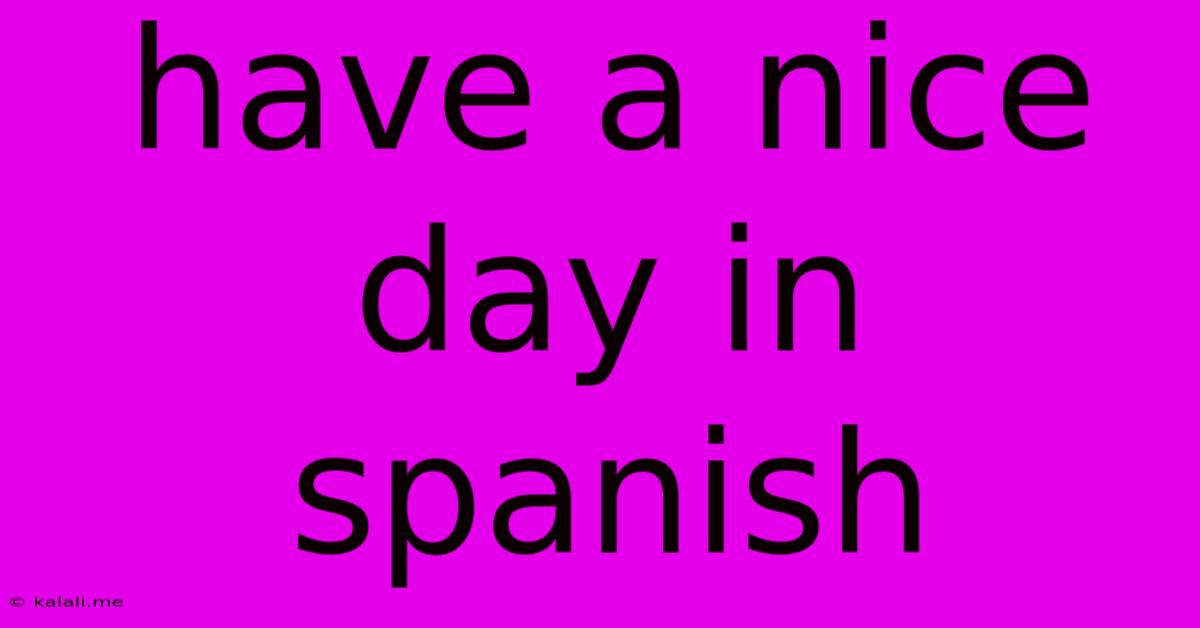Have A Nice Day In Spanish
Kalali
May 23, 2025 · 3 min read

Table of Contents
Have a Nice Day in Spanish: More Than Just "Que Tenga Un Buen Día"
Want to wish someone a pleasant day in Spanish? While "Que tenga un buen día" is a perfectly acceptable and widely used phrase, there's a whole spectrum of ways to express this simple sentiment, depending on the context and your relationship with the person. This article explores various options, helping you choose the perfect phrase for any situation and boosting your Spanish conversational skills. This guide also provides tips on how to naturally incorporate these phrases into your daily interactions.
More than just a greeting: Saying "Have a nice day" in Spanish is more than just a polite formality; it's a way to connect with someone and show you care. The right phrase can make a big difference in leaving a positive and lasting impression.
Common Ways to Say "Have a Nice Day" in Spanish
-
Que tenga un buen día: This is the most common and widely understood translation. It's a formal and polite way to wish someone a good day. It literally translates to "May you have a good day."
-
Que tengas un buen día: This is the informal version, used with friends, family, and people you know well. The verb conjugation changes to reflect the informal "you."
-
¡Que tengas un lindo día!: This translates to "Have a lovely day!" It's a slightly more affectionate and warmer way to express your well wishes. It's suitable for both formal and informal settings.
-
¡Pase un buen día!: This translates to "Have a good day!" This phrase is slightly more formal than "Que tenga un buen día."
-
¡Buen día!: This is a shorter, more concise way to say "Good day!" or "Have a good day!" It is widely understood, particularly in Latin America.
Choosing the Right Phrase: Context Matters
The best way to say "Have a nice day" in Spanish depends heavily on context:
- Formality: Use formal phrases like "Que tenga un buen día" or "¡Pase un buen día!" with strangers, colleagues, or people you don't know well.
- Informality: Use informal phrases like "Que tengas un buen día" or "¡Que tengas un lindo día!" with friends, family, and close acquaintances.
- Time of day: While these phrases generally work throughout the day, consider alternatives like "Buenas tardes" (Good afternoon) or "Buenas noches" (Good evening/Good night) depending on the time.
Beyond the Basics: Enhancing Your Spanish Greetings
To make your greetings even more natural and engaging, consider adding these elements:
- Adding a personal touch: "Que tengas un buen día, [name]" adds a personal touch and makes the greeting more friendly.
- Expressing hope: You could add phrases like "espero que tengas un buen día" (I hope you have a good day) to convey your sincerity.
- Contextual phrases: Consider the situation. If someone is going to a meeting, you might say "Que tengas un buen día en tu reunión" (Have a good day at your meeting).
By learning and utilizing these various phrases and tips, you can confidently and effectively wish someone a pleasant day in Spanish, enriching your interactions and demonstrating your language skills. Remember, practicing these phrases in conversation will solidify your understanding and make you more comfortable using them in real-life situations.
Latest Posts
Latest Posts
-
Do Fruits Reapere After Is Before User Dies
May 23, 2025
-
How To Fill A Screw Hole In Wood
May 23, 2025
-
How To Get Rid Of Seperation Line In In Design
May 23, 2025
-
How Do I Wire Two Lights To One Switch
May 23, 2025
-
What Does Open Ground Mean On Outlet
May 23, 2025
Related Post
Thank you for visiting our website which covers about Have A Nice Day In Spanish . We hope the information provided has been useful to you. Feel free to contact us if you have any questions or need further assistance. See you next time and don't miss to bookmark.